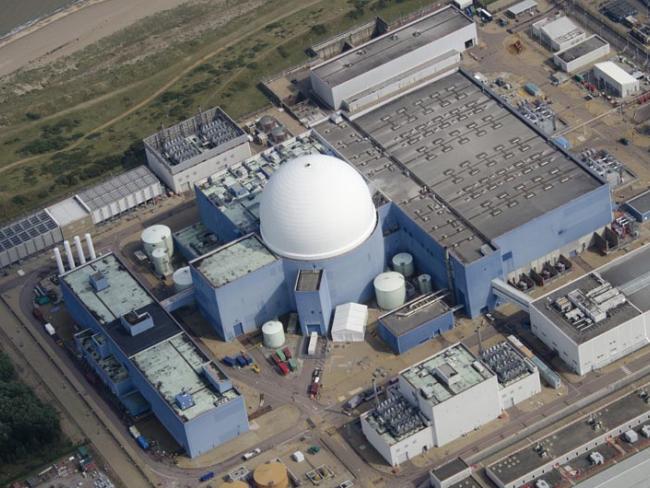
Sizewell B, in Suffolk: Britain’s most modern nuclear station, it started producing power nearly three decades ago. Photo John Fielding (CC BY 2.0).
Reluctant to invest in infrastructure, successive governments have failed to keep in step with public support for nuclear – and failed, too, to provide the clean electricity that nuclear can deliver…
Britain was a pioneer in atomic power generation. Yet in 2022, nuclear power provided only 13.9 per cent of total electricity supplied in Britain. Its contribution has fallen significantly since the 1990s, when it provided around a quarter of Britain’s total electricity supply. Governments have failed to keep pace with growing public support for nuclear power by replacing our ageing nuclear reactors with modern ones.
Since 1995 there have been eight nuclear plant closures, with no new plants coming online, reducing installed nuclear capacity by more than a quarter. The rise of renewable energy has not compensated for the cuts in nuclear capacity, even though renewables’ share of electricity generation rose from 3 per cent in 2000 to 42 per cent in 2022.
Remember all the promises about cheap renewable energy? It hasn’t exactly worked out like that. Instead Britain has relied on gas-powered generation and biomass to cover shortfalls in renewables.
Falling
As reported by the House of Commons Science, Innovation and Technology Committee, nuclear power output is due to decrease further over the coming years. The Committee notes that the contribution of nuclear to Britain’s energy mix will “fall substantially by 2028, when all plants bar Sizewell B are scheduled to come to the end of their lives.”
That means trouble. The capacity increase offered by the Hinkley Point C plant – currently under construction and due to come online later in the decade – will be outweighed by these upcoming retirements.
Hinkley Point C is the first new nuclear power station to be built in Britain since 1987. A second new plant is planned as Sizewell C in Suffolk. Both are dual plants, with two reactors each.
We have fallen behind other countries. By comparison, France currently has nine times more nuclear capacity than Britain. For decades, successive governments have failed to make the necessary investments in British nuclear power.
The government published Powering Up Britain, its energy security plan, in March 2023 which included a plan for more nuclear power “up to 24 GW” by 2050. This plan is short on detail, but this would represent three times the current levels and almost double the highest nuclear installed capacity Britain has ever achieved. The wording “up to” is also an excuse for not reaching that target of 24 GW.
‘Remember all the promises about cheap renewable energy? It hasn’t happened.’
When both Hinkley Point C and Sizewell C come online, the total of these two new reactors will be around 6.4 GW. Before Sizewell B reaches end of life that will add some capacity, but only a small amount as it is running below its theoretical capacity of just under 1.2 GW. The chance of achieving anywhere near 24 GW of nuclear capacity by 2050 is remote unless small modular reactor (SMR) capacity expands rapidly.
SMRs are advanced nuclear reactors that have a power capacity of up to 300 MW, which is about a quarter of the theoretical capacity of Sizewell B. Hinkley Point C and Sizewell C each have a total of about 3200 MW. The advantage of SMRs is in the modular nature, with the option to manufacture then ship them to install on site.
What is clear is that nuclear power is a better long-term option to reduce CO2 emissions than gas-powered generation or biomass, although these options will be needed for some time yet. And CO2 emissions from nuclear are comparable to those from wind power over the production life cycle.
Predictably, Greenpeace is opposed to any expansion of nuclear power. Interestingly, an article in The Guardian highlighted that young climate activists in Europe are in favour of nuclear power and called on Greenpeace to drop its “old-fashioned and unscientific” campaign against nuclear power.
Opposition
You could say the same of the Green Party, the Liberal Democrats and the SNP, who are all opposed. Scotland’s last remaining nuclear power plant in Torness is due to close in 2028. The people of Scotland are in favour of nuclear power (see below) so the SNP have no justification for opposing it.
The Labour Party has expressed support for nuclear power. Keir Starmer described it as a “critical part of the UK’s energy mix” including Hinkley and Sizewell new reactors as well as SMRs. Whether this translates into action remains to be seen.
What do the British people think? Since 2012 support for nuclear power has been slowly increasing while the percentage of those opposing has fallen from 27 to 11, according to Statistica Research. But most recently, support increased significantly over less than two years, according to research from the Stonehaven Global consultancy. The research looked at polls from July 2021 to January 2023 based on net positive or negative support and how attitudes have changed.
Net support is defined as the percentage of people who support nuclear power minus the percentage of people who oppose it. Net support has increased overall from minus 1 per cent in July 2021 to plus 24 per cent in January 2023.
Net support maps show regional support for June 2021 and February 2023. Scotland for example has gone from minus 9 per cent to plus 25 per cent (even though among SNP voters support is negative). All areas of Britain now have positive support for nuclear power, which was not the case in 2021. There is also significant support on key energy statements. For example 87 per cent agree that “It is critical that the UK becomes much more self-sufficient for our energy.”
The real question is how this support can be maintained.
